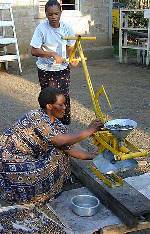Pressing Jatropha
Pressing Jatropha
Find out how jatropha oil is extracted for use in biodiesel
home > biomassJatropha is a high oil-yield crop grown around the world for biodiesel production.

Jatropha trees develop fruit during the winter the leaves have fallen - however in optimal conditions (warm temperatures and moist soil) several crops per year are possible. The fruits form in buches of around 10 and are initially olive green in colour. Over the following three or so months, the seeds contained within the fruits mature while the fruit changes from green to yellow to black.
At this stage the fruits should be harvested either by hand or using olive harvesting equipment. The fruit is made up of a husk (seed coat) which must be removed (can be composted), and the jatropha seeds which hold the oil. After a couple of days of sun-drying the seeds can easily be popped out of the fruits by hand.

Seeds must be well dried before pressing since moist seeds can develop mould and can also jam the pressing equipment. Pressing of the seeds is carried out by a mechanical seed press human-powered or with an electric or diesel motor. Where a direct injection diesel motor is used to power the seed press, pressed oil can be used directly as a fuel - typically around 5% of the pressed oil would be used in this way. There is no need to heat the seeds - warm ambient temperatures are sufficient to obtain high yields with cold pressing.

Pictured above is a human-powered jatrapha seed press in action. Pictured below is a close up of a similar press. The seeds fall down from the hopper and are crushed by a revolving screw which presses out the jatropha oil The oil drips down and can be captured in a container.

Find out more about Jatropha and its uses in our Jatropha for Biodiesel Figures article.
Comment on this Article
If you have any comments on this article, please email them to neil@reuk.co.uk.Related Articles
Click one of the links below for further articles on the following relevant topics:biomass.